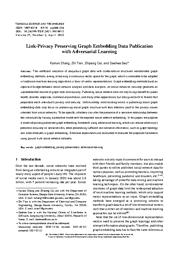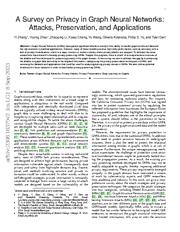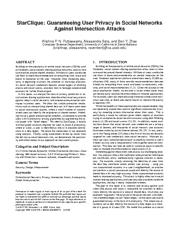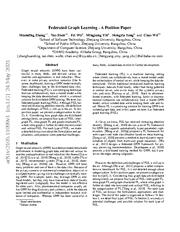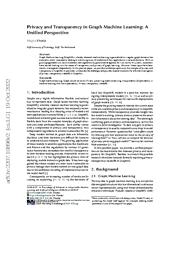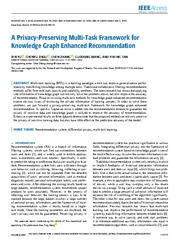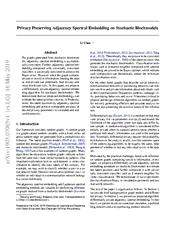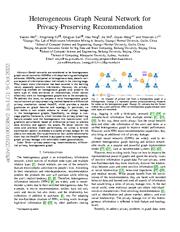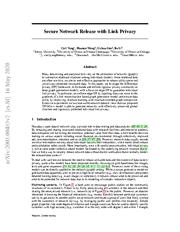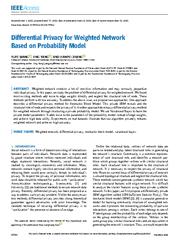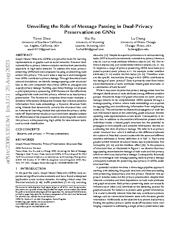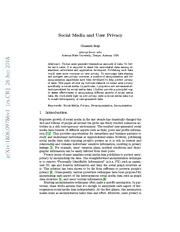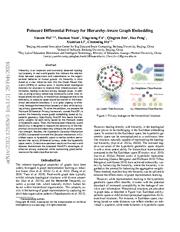A copy of this work was available on the public web and has been preserved in the Wayback Machine. The capture dates from 2022; you can also visit the original URL.
The file type is application/pdf.
Filters
Link-privacy preserving graph embedding data publication with adversarial learning
2022
Tsinghua Science and Technology
The inefficient utilization of ubiquitous graph data with combinatorial structures necessitates graph embedding methods, aiming at learning a continuous vector space for the graph, which is amenable to ...
Unfortunately, most existing works in publishing social graph embedding data only focus on preserving social graph structure with less attention paid to the privacy issues inherited from social networks ...
The authors would like to thank the referees for their valuable comments and helpful suggestions. ...
doi:10.26599/tst.2021.9010015
fatcat:iitghcf4kfgkvk5lsq5whnbdxa
Adversarial Privacy Preserving Graph Embedding against Inference Attack
[article]
2020
arXiv
pre-print
The proposed method preserves the structural information and utility attributes of a graph while concealing users' private attributes from inference attacks. ...
Recently, the surge in popularity of Internet of Things (IoT), mobile devices, social media, etc. has opened up a large source for graph data. ...
For example, from network structure to control flow graph, IoT naturally generates a large amount of graph data continuously. ...
arXiv:2008.13072v1
fatcat:nrchmex4srg35jboi2ghw4jkdm
A Survey on Privacy in Graph Neural Networks: Attacks, Preservation, and Applications
[article]
2023
arXiv
pre-print
Despite this progress, there is a lack of a comprehensive overview of the attacks and the techniques for preserving privacy in the graph domain. ...
In this survey, we aim to address this gap by summarizing the attacks on graph data according to the targeted information, categorizing the privacy preservation techniques in GNNs, and reviewing the datasets ...
Latent Factor Disentangling Graph/node embedding is able to preserve sensitive and non-sensitive information of the original graph. ...
arXiv:2308.16375v3
fatcat:y2yumkumbjbi5emiw5ytukxbw4
StarClique
2009
Proceedings of the 5th international conference on Emerging networking experiments and technologies - CoNEXT '09
We identify StarClique, a locally minimal graph structure required for users to attain k-anonymity, where at worst, a user is identified as one of k possible contributors of a data object. ...
Modeling this as a graph anonymization problem, we propose to provide users with k-anonymity privacy guarantees by augmenting the social graph with "latent edges." ...
Any opinions, findings, and conclusions or recommendations expressed in this material are those of the authors and do not necessarily reflect the views of the National Science Foundation. ...
doi:10.1145/1658939.1658958
dblp:conf/conext/PuttaswamySZ09
fatcat:bbjxoy7fqndcvlmbsxjl32tnxu
Federated Graph Learning – A Position Paper
[article]
2021
arXiv
pre-print
Considering how graph data are distributed among clients, we propose four types of FGL: inter-graph FL, intra-graph FL and graph-structured FL, where intra-graph is further divided into horizontal and ...
However, in some privacy sensitive scenarios (like finance, healthcare), training a GNN model centrally faces challenges due to the distributed data silos. ...
In addition to feature and label, graph data have edge (structure) information, which indicates Non-IID of graph structure might influence the learning process as well. ...
arXiv:2105.11099v1
fatcat:6bhzsfiwwvgndizffwokpuiaym
Privacy and Transparency in Graph Machine Learning: A Unified Perspective
[article]
2022
arXiv
pre-print
In particular, we describe the challenges and possible research directions for a formal investigation of privacy-transparency tradeoffs in GraphML. ...
With its growing applicability to sensitive domains and regulations by governmental agencies for trustworthy AI systems, researchers have started looking into the issues of transparency and privacy of ...
While transparency provides insight into the model's working, privacy aims to preserve the sensitive information about the training data 1 . ...
arXiv:2207.10896v2
fatcat:arpffmwwrvhytdoqvn5mmllrpi
A Privacy-preserving Multi-task Framework for Knowledge Graph Enhanced Recommendation
2020
IEEE Access
However, existing multi-task methods for knowledge graph enhanced recommendation expose obvious issues of disclosing the private information of training samples. ...
In order to solve these problems, we put forward a privacy-preserving multi-task framework for knowledge graph enhanced recommendation. ...
ACKNOWLEDGMENT The authors wish to thank the editors and anonymous reviewers for their valuable comments and helpful suggestions which greatly improved the articles quality. ...
doi:10.1109/access.2020.3004250
fatcat:vez6quthszaynglwzbaowuh6be
Privacy Preserving Adjacency Spectral Embedding on Stochastic Blockmodels
[article]
2019
arXiv
pre-print
However when the graph contains private or sensitive information, treating the data as non-private can potentially leak privacy and incur disclosure risks. ...
For graphs generated from stochastic blockmodels, adjacency spectral embedding is asymptotically consistent. ...
Presented at the ICML 2019 Workshop on Learning and Reasoning with Graph-Structured Data Copyright 2019 by the author(s). ...
arXiv:1905.07065v1
fatcat:w2pevf2yq5arndetxhlc6fozxu
Heterogeneous Graph Neural Network for Privacy-Preserving Recommendation
[article]
2022
arXiv
pre-print
HGNNs, compared to homogeneous data, absorb various aspects of information about individuals in the training stage. ...
However, the privacy-preserving methods on homogeneous graphs only preserve the same type of node attributes or relationships, which cannot effectively work on heterogeneous graphs due to the complexity ...
Some early works attempted to preserve the privacy of graph data and achieved meaningful results. ...
arXiv:2210.00538v2
fatcat:wrr4zd5vancp5kwrfsmnnc7vh4
Secure Deep Graph Generation with Link Differential Privacy
[article]
2021
arXiv
pre-print
Many data mining and analytical tasks rely on the abstraction of networks (graphs) to summarize relational structures among individuals (nodes). ...
Since relational data are often sensitive, we aim to seek effective approaches to generate utility-preserved yet privacy-protected structured data. ...
for rigorous individual link privacy protection, and further ensures structure-oriented graph comparison for effective global network structure preservation. ...
arXiv:2005.00455v3
fatcat:uwlt42ndqrctlbuek3w527guze
Differential Privacy for Weighted Network Based on Probability Model
2020
IEEE Access
Weighted network contains a lot of sensitive information and may seriously jeopardize individual privacy. In this paper, we study the problem of differential privacy for weighted network. ...
This private SBM reveals and the structural role of node and respects the privacy of it. ...
To respect the privacy of personal information, network data should be released for public with ''sanitization''. ...
doi:10.1109/access.2020.2991062
fatcat:bzigvbwwmja3dhlq7cywtbykum
Enhanced Clustering Based OSN Privacy Preservation to Ensure k-Anonymity, t-Closeness, l-Diversity, and Balanced Privacy Utility
2023
Computers Materials & Continua
The proposed approach outperformed the underlying state of art methods for Degree of Anonymization, computational efficiency, and information loss. ...
The threshold value is determined based on the supplied OSN data of edges, nodes, and user attributes. Clusters are k-anonymized with multiple graph properties by a novel one-pass algorithm. ...
Funding Statement: The authors received no specific funding for this study.
Conflicts of Interest: The authors declare they have no conflicts of interest to report regarding the present study. ...
doi:10.32604/cmc.2023.035559
fatcat:fzkathwff5et3gezgktxapg73y
Unveiling the Role of Message Passing in Dual-Privacy Preservation on GNNs
[article]
2023
arXiv
pre-print
Experimental results on four benchmark datasets validate the effectiveness of the proposed model in protecting both node and link privacy while preserving high utility for downstream tasks, such as node ...
Graph Neural Networks (GNNs) are powerful tools for learning representations on graphs, such as social networks. ...
ACKNOWLEDGEMENTS This material is in part supported by the Cisco Research Gift Grant. ...
arXiv:2308.13513v1
fatcat:ac44ldklybca7glecrbdoupuoe
Social Media and User Privacy
[article]
2018
arXiv
pre-print
Online users generate tremendous amounts of data. To better serve users, it is required to share the user-related data among researchers, advertisers and application developers. ...
My work sheds light on new privacy risks in social media data due to innate heterogeneity of user-generated data. ...
Acknowledgments This material is an extended abstract of my work published in the 29th ACM conference on Hypertext and Social Media [1] . ...
arXiv:1806.09786v1
fatcat:4spmpgofmzetpizfand5ry27re
Poincaré Differential Privacy for Hierarchy-Aware Graph Embedding
[article]
2024
arXiv
pre-print
It is of great urgency to effectively leverage the hierarchical property of data while satisfying privacy guarantees. ...
As hierarchy is introduced as a new inductive bias into the Graph Neural Networks (GNNs) in various tasks, it implies latent topological relations for attackers to improve their inference attack performance ...
This paper is supported by the National Key Research and Development Program of China Grant (No. 2022YFB4501901) and the National Natural Science Foundation of China (No. U21A20474 and 62302023). ...
arXiv:2312.12183v3
fatcat:iedrhde5afdt7fhky2f4glh5jq
« Previous
Showing results 1 — 15 out of 5,406 results

